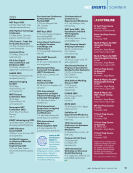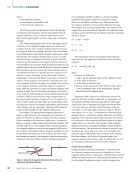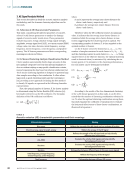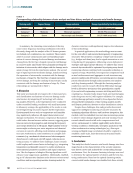Materials Technology Institute (MTI)
invites individuals within the process
industries to submit abstracts for tech-
nical presentations or case studies
focused on a selection of session topics,
including emerging technology, safety/
reliability, failures and failure analyses,
materials for harsh environments, and
nonmetallics. Proposals should present
cutting-edge research, innovative strate-
gies, or practical solutions.
Important dates:
Ñ 3 July 2025 – Abstract submissions
deadline
Ñ Late August 2025 – Acceptance
notification
Ñ 10 November 2025 – First drafts due
Presentations will be scheduled for
24–25 February 2026. Visit https://
www.mti-global.org/mtisymposium
for submission guidelines. Speakers
receive discounted registration to the
symposium.
CALL FOR
PRESENTATIONS:
APCNDT 2026
Step into the spotlight as a presenter at
APCNDT 2026, the premier Asia Pacific
Conference on Non-destructive Testing,
to be held 11–15 May 2026 in Honolulu,
Hawaii. With the theme “Breaking
Barriers: NDT Solutions for a Changing
World – Innovate, Adapt, Transform,” this
international gathering provides a unique
platform to showcase your expertise,
share groundbreaking research, and
contribute to the future of NDT on a
global scale.
Proposal content should reflect
cutting-edge, forward-thinking topics
in the areas of NDT application, tech-
nology, or professional development.
Presentations on up-and-coming
methods, new innovations in equipment,
unique ideas, and new technology are
encouraged.
Potential topics include:
Ñ NDT methods
Ñ Industry applications
Ñ Professional development
Ñ Codes and standards
Visit https://www.apcndt2026.com/
present for presentation format options
and submission information and portal.
The proposal deadline is 31 October
2025. Speakers will be notified of accep-
tance on 9 January 2026 and must
register by 13 March 2026. The presenta-
tion submission deadline is 24 April 2026.
CALL FOR 2025 ASNT
WEBINAR SPEAKERS
ASNT is recruiting speakers for its recur-
ring webinar series, and we invite you to
submit your topic for consideration. ASNT
webinars can be hosted by one speaker
or a panel of speakers depending on the
topic. Webinars are 1 h long with 10 min
embedded for Q&A and are typically
held at 12:00 or 1:00 pm (ET) during the
month. We’re open to webinars hosted
in English and Spanish (with a moderator
provided by the speaker), and we may be
open to other languages depending on
topic and interest.
Potential topics may include:
Ñ Phased array ultrasonic testing
Ñ Time of flight diffraction
Ñ AR/AI in NDT
Ñ Eddy current
Ñ Thermography
Ñ Computed radiography
Ñ NDT in aerospace
Ñ Unique NDT applications
Ñ Level I/II introductory topics
Ñ Safety in NDT
Ñ Business management of NDT
If you have a technical topic you’d like
to submit for consideration, visit asnt.org/
education/courses-by-format/webinars
to complete the webinar speakers form.
ELEVATE YOUR NDT
TRAINING PROGRAM
ASNT Certification Services LLC offers an
Authorized Training Organization (ATO)
Accreditation Program to recognize and
support NDT training providers that
uphold the highest industry standards
for excellence.
Becoming an accredited ATO offers
numerous advantages. It provides
formal recognition of excellence in NDT
training, enhancing your organization’s
credibility and helping you attract
and retain students. Accredited ATOs
also gain access to valuable resources,
including training materials, marketing
support, and networking opportunities.
Additionally, they have the opportunity
to influence the future of NDT training
by actively contributing to the develop-
ment of industry standards.
Achieving ASNT ATO accreditation
demonstrates your commitment to
providing top-tier NDT training. The
program evaluates both administrative
and operational aspects to ensure
quality, consistency, and compliance
with industry benchmarks.
Detailed program information
and requirements are available at
asntcertification.org/ato. Questions
about the program or the application
process can be sent to ato@asnt.org.
ICENDE 2025
ASNT India invites readers to the highly
anticipated ICENDE 2025 Conference, a
landmark event in nondestructive eval-
uation. This conference brings together
the brightest minds, innovators,
and influencers in the NDE industry,
providing unparalleled opportunities
for networking, learning, and collab-
oration. The conference will be held
20–22 August 2025 in Maradu, Kochi,
India. Visit icende.in to register.
|
SOCIETYNOTES
M AY 2 0 2 5 • M AT E R I A L S E V A L U AT I O N 65
invites individuals within the process
industries to submit abstracts for tech-
nical presentations or case studies
focused on a selection of session topics,
including emerging technology, safety/
reliability, failures and failure analyses,
materials for harsh environments, and
nonmetallics. Proposals should present
cutting-edge research, innovative strate-
gies, or practical solutions.
Important dates:
Ñ 3 July 2025 – Abstract submissions
deadline
Ñ Late August 2025 – Acceptance
notification
Ñ 10 November 2025 – First drafts due
Presentations will be scheduled for
24–25 February 2026. Visit https://
www.mti-global.org/mtisymposium
for submission guidelines. Speakers
receive discounted registration to the
symposium.
CALL FOR
PRESENTATIONS:
APCNDT 2026
Step into the spotlight as a presenter at
APCNDT 2026, the premier Asia Pacific
Conference on Non-destructive Testing,
to be held 11–15 May 2026 in Honolulu,
Hawaii. With the theme “Breaking
Barriers: NDT Solutions for a Changing
World – Innovate, Adapt, Transform,” this
international gathering provides a unique
platform to showcase your expertise,
share groundbreaking research, and
contribute to the future of NDT on a
global scale.
Proposal content should reflect
cutting-edge, forward-thinking topics
in the areas of NDT application, tech-
nology, or professional development.
Presentations on up-and-coming
methods, new innovations in equipment,
unique ideas, and new technology are
encouraged.
Potential topics include:
Ñ NDT methods
Ñ Industry applications
Ñ Professional development
Ñ Codes and standards
Visit https://www.apcndt2026.com/
present for presentation format options
and submission information and portal.
The proposal deadline is 31 October
2025. Speakers will be notified of accep-
tance on 9 January 2026 and must
register by 13 March 2026. The presenta-
tion submission deadline is 24 April 2026.
CALL FOR 2025 ASNT
WEBINAR SPEAKERS
ASNT is recruiting speakers for its recur-
ring webinar series, and we invite you to
submit your topic for consideration. ASNT
webinars can be hosted by one speaker
or a panel of speakers depending on the
topic. Webinars are 1 h long with 10 min
embedded for Q&A and are typically
held at 12:00 or 1:00 pm (ET) during the
month. We’re open to webinars hosted
in English and Spanish (with a moderator
provided by the speaker), and we may be
open to other languages depending on
topic and interest.
Potential topics may include:
Ñ Phased array ultrasonic testing
Ñ Time of flight diffraction
Ñ AR/AI in NDT
Ñ Eddy current
Ñ Thermography
Ñ Computed radiography
Ñ NDT in aerospace
Ñ Unique NDT applications
Ñ Level I/II introductory topics
Ñ Safety in NDT
Ñ Business management of NDT
If you have a technical topic you’d like
to submit for consideration, visit asnt.org/
education/courses-by-format/webinars
to complete the webinar speakers form.
ELEVATE YOUR NDT
TRAINING PROGRAM
ASNT Certification Services LLC offers an
Authorized Training Organization (ATO)
Accreditation Program to recognize and
support NDT training providers that
uphold the highest industry standards
for excellence.
Becoming an accredited ATO offers
numerous advantages. It provides
formal recognition of excellence in NDT
training, enhancing your organization’s
credibility and helping you attract
and retain students. Accredited ATOs
also gain access to valuable resources,
including training materials, marketing
support, and networking opportunities.
Additionally, they have the opportunity
to influence the future of NDT training
by actively contributing to the develop-
ment of industry standards.
Achieving ASNT ATO accreditation
demonstrates your commitment to
providing top-tier NDT training. The
program evaluates both administrative
and operational aspects to ensure
quality, consistency, and compliance
with industry benchmarks.
Detailed program information
and requirements are available at
asntcertification.org/ato. Questions
about the program or the application
process can be sent to ato@asnt.org.
ICENDE 2025
ASNT India invites readers to the highly
anticipated ICENDE 2025 Conference, a
landmark event in nondestructive eval-
uation. This conference brings together
the brightest minds, innovators,
and influencers in the NDE industry,
providing unparalleled opportunities
for networking, learning, and collab-
oration. The conference will be held
20–22 August 2025 in Maradu, Kochi,
India. Visit icende.in to register.
|
SOCIETYNOTES
M AY 2 0 2 5 • M AT E R I A L S E V A L U AT I O N 65













































































